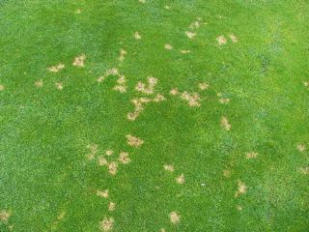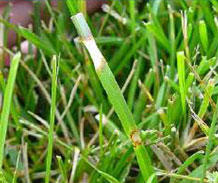
Dollar Spot



Ultralawn Incorporated
1055 East 260th Street
Euclid, OH 44132
216.731.7756
440.951.3738
Office hours Monday-Friday 9-3 call today with any questions

Symptoms: Dollar spot disease of turf grass is named for the straw-
colored, silver dollar-sized spots that appear on turf. The disease
causes larger spots on higher cut turf grass. Dollar spot disease of
lawns usually appears in somewhat irregular circles 3 to 6 inches in
diameter. Examining individual leaves can make a more certain
diagnosis of this disease. The typical dollar spot lesion is straw
colored and girdles the entire leaf blade. The top and bottom
borders of the lesion are usually dark reddish-brown. The lesion
often has an hourglass shape. If the infected grass is examined in
the morning while dew is still present, the white web-like mycelium
of the fungus may be observed.
Season: Dollar spot is most common in early summer, late
summer, and early fall in humid weather with warm days and cool
nights. Dollar spot is less prominent in very hot weather.
Disease Cycle: In humid weather, the grass plants exude sugars and other nutrients during the night in
droplets. This provides a nutrient source for the fungi to begin to grow on the
surface of the leaf blades and initiate infections. Turf grasses appear to be more
susceptible to infection when they are nutrient-deficient and when the soil is
dry. Both factors reduce the growth of the grass plants.
Damage: Usually, only the leaf blades become infected. Dollar spot rarely
causes severe damage on lawn grasses. All turf grasses are susceptible to dollar
spot disease, but some Kentucky bluegrass cultivars are relatively resistant.
Cultural Management: Dollar spot disease usually occurs on lawns that are
nitrogen-deficient. Applications of fertilizer will stimulate growth, so the infected
leaf blades may be mowed off. Sufficient water should be applied when rainfall
is sparse. Thick thatch stresses the turf grass and increases dollar spot. If dollar
spot is present in the lawn, it is best to mow only when the grass is dry and remove the clippings. This will
prevent the disease from spreading. Mow the grass high and do not remove more than 1/3 of the leaf blade at
a single cutting to avoid stress. Water deeply and infrequently. Light sprinklings, especially late in the day, will
increase disease.
Chemical Management: Dollar spot disease responds readily to fungicides, but an application of fertilizer
and attention to watering practices is usually sufficient to minimize the disease. Dollar spot rarely causes
sufficient injury to lawns; however, a fungicide application can be applied to help in quicker recovery.

These spots in the lawn are approximately the size of a
half-dollar.

Look closely at the hour glass shaped
lesions.


















